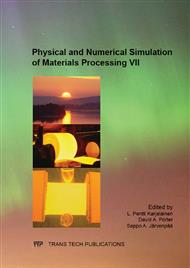p.248
p.253
p.261
p.266
p.277
p.283
p.289
p.295
p.301
Hybrid Modeling of Flat Rolling Process during Hot Rolling
Abstract:
Mathematical Modeling is an effective technique for prediction of process parameters in industrial processes. Artificial Neural Network (ANN) technique has also been used to recognize a pattern in the given data by training itself. Further the trained network is used for future prediction of process parameters on the basis of the pattern recognition. The mathematical models are based on some ideal assumptions which are not valid in practical industrial conditions. Similarly high variability in industrial data makes pattern recognition difficult for ANN models and leads to high errors of prediction. In the present work, an attempt has been made to develop a hybrid model by integrating two mathematical models and ANN model for prediction of roll force during hot rolling of flat rolled steel products. The mathematical equations for roll force have been derived from the pressure distribution equation derived by Sims and Tselikov. A feed-forward network with back-propagation algorithm has been selected for ANN. All the three methods have been converted into computer code using Visual Basic.Net programming language. The hybrid model has been trained with about 2500 hot rolled steel coil data collected from Bokaro Steel Plant and Rourkela Steel Plant consisting of three different steel grades. The hybrid model has been validated with measured data of about 1000 coils. Combinations of ANN network in hybrid model having different number of hidden neurons and learning rate have been formulated, trained and validated. The final hybrid model has been selected from these combinations which has maximum accuracy. Also Multi-variable optimization technique can be used to find out the values for various input conditions which affect the flow stress and the roll force, minimizing the Root Mean Square Error. When comparing the root mean square error (RMSE) of model, it has been found that the RMSE of hybrid model is about 25% less than that of Mathematical Model.
Info:
Periodical:
Pages:
277-282
Citation:
Online since:
July 2013
Authors:
Price:
Сopyright:
© 2013 Trans Tech Publications Ltd. All Rights Reserved
Share:
Citation:


